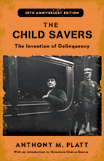At a time when there is an ongoing and massive hunger strike by prisoners protesting conditions in isolation housing in California state prisons, this topic is very current.
Our meeting to discuss The Child Savers was fantastic. This book selection was a bit of a stretch for us- it was far more academic than the books we normally read. However, our book club members rose to the occasion, and we had a great conversation. Some issues that came up in the book were very familiar to us--it's amazing how history repeats itself sometimes-- including:
- a tendency to idealize the past (the good old days, when kids grew up in the fresh country air)
- a tendency to make assumptions about other people based on our own experiences and beliefs
- an inherent danger in reform efforts in terms of unintended consequences
- the long-term struggle of reform and the power of old institutionalized ways
- the power of profiling based on race, class, and gender
- the dissonance of competing ideas that seem to be inherent to incarceration: rehabilitation or punishment; improving character or reforming deviant behavior; protecting juveniles from bad environments or protecting society from criminals
We also found some very important questions coming up: when many people in society are afraid of criminals, and want them kept literally and figuratively on the fringes of society, people do not understand or empathize with criminals, and tend to think that incarcerated criminals 'get what they deserve' when incarcerated, and even assume that people "give up" their rights when the decide to break the law.
And finally: some really great solutions that came up during our discussion (and after):
1) change awareness about basic human rights (these are not changed or lost because of criminality): HRW points this out in their reports on prisoners all over the world: from Burma and Uganda to the USA's high level policies and practices.
2) talk to people, discover what they need and want (not what you think they need and want): HRW does this kind of work, since their researchers actually talk to prisoners in the process of writing their reports. Years ago, the LA WRC send members to interview inmates, and the ongoing review of LWOP surveys is another example.
3) help people find a good way out of cycles of poverty, crime, and violence: great examples are the literacy projects in which prisoners are encouraged to read, creatively express themselves, or earn a degree (sadly, these opportunities are generally lacking); vocational training in skilled, lucrative jobs such as welding or dog training.
Original Post:
For the summer, we are trying something a little new: this book is more academic in style than we usually read- but it is a classic: Rutgers University Press just came out with a 40th Anniversary Expanded Edition!
This is a book that has played a central role in juvenile justice debates in the US. It is also of particular interest to our group because the book approaches the question of juvenile delinquency by looking specifically at several women who played key roles in policy development; because the book itself influenced feminist history and feminist social policy; and because the subject matter of the book will bring us full-circle back to some of the themes of our last book, Girls Like Us. In our reading of Rachel Lloyd's powerful book, we were struck with the lack of support systems for the girls who were caught up in the law enforcement/juvenile justice/incarceration cycle. One of Rachel's key arguments is that these girls are not criminals- they should not be treated like women who break the law, because they are under the age of consent and they are often coerced, tricked, or even brutally forced to participate in the illegal sex industry. However, many law enforcement officials argue that the only thing they can do is to arrest these girls, because it is the only way to get them off the street. There are no social services or programs to support these girls, but jail is a place where the girls are safe from their pimps and can get off drugs (this in itself indicates some incredibly sad truths about the world that these girls live in). But there are serious problems with criminalizing the girls, as Rachel Lloyd points out: the whole world the girls live in needs to change, and punishing the girls is not going to help with that.
Reading about this world, about the challenges faced by these girls, and about the criminal behavior of the men who are pimps-- who are generally from the same neighborhoods, families, and socio-economic backgrounds as the girls are-- prompted us to ask a lot of questions about juvenile justice, about criminalization of adolescents' bad behavior, about how boys and girls experience poverty and violence differently, and about the history of juvenile justice in the US. We know that many young men (and some young women) are getting caught up in the adult prison system through life without parole (LWOP), mostly through the amazing work done on the issue by Elizabeth Calvin in the LA office of HRW. Reading this book will deepen our understanding of the issues.
